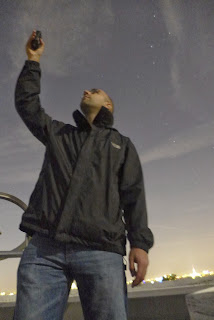When you look at the night sky, do you see the same number of stars as your best friend? That's the question we want to answer with our first ever "Flashmob für die Wissenschaft". We want to get as many people as possible to use the Loss of the Night app in the exact same place at the exact same time. By comparing the stars the flashmobbers can see to each other, we'll learn how consistent the results from the app are.
The event will take place in Berlin, but no matter where you live we could use your help to get the word out. Post it to Facebook, tweet or email it to bloggers you know, and if you do live in Berlin tell your friends and colleagues about it. You can pass them the link to this blog post.
And of course, as long as it's clear where you live, you can meet up with friends and do observations in your own city!
Here's how the event will work:
Flashmobbers should download the app in advance. Android users should download the Loss of the Night app, and iOS users can take part using the Dark Sky Meter app (free or full version), which uses the phone's camera instead of your eyes. If you want, you can test out the app in the daytime to get a feel for it works.
Plan to arrive in the middle of Gleisdreieck Park in Berlin starting around 20:30 (the location of the green arrow, not the "A" on this map). If you want, you can start the app as soon as you're there, so that your phone is already in night mode when the measurement time starts. Spend some time looking at the stars and letting your eyes adapt to the dark - I promise you'll be surprised how many stars are still visible from Berlin!
As soon as astronomical twilight ends and true night starts at 20:35, we'll signal the crowd that it's time to start searching for stars.
Once you've observed 7 stars, the app will tell you that you can stop if you like. PLEASE DON'T STOP! Observing more stars is always a huge help to us, and will be particularly important for getting the most out of the flashmob data. So we'd really appreciate it if you look for at least 12 stars. If you have the patience for 15-20, that would be amazing, and if you get to 30, you'll be a Citizen Science Superhero!
When you're done looking for stars, just turn off the app and head home - your data is sent to us automatically when you quit the app. If you have a good location from which to observe the app close to your home (e.g. a local park, playground, or rooftop balcony), then it would be really fantastic if you would do a 2nd observation. In this way, we'll also get a huge amount of data from around Berlin. But please only use the app if you've got a partner with you who can watch out for potential hazards (e.g. making sure you don't trip over something while you're looking up!).
Please share news about this event with everyone you know, by passing them the link to this blog post! The more people that show up, the more successful the event will be.
I hope to see many of you tomorrow night!
 |
| I will measure the sky brightness with a light meter, and compare the result to the Flahsmobber's observations. |
Notes:
(1) If you want more information about why we want people to do observations rather than satellites or other sensors, take a look at our first blog post, or this Scientific American article. For background on why light pollution is important, read this article in The Guardian, or this one from the Why Files.
(2) If there is a small cloud right above Gleisdreieck Park and it looks like it's going to move out of the way, then we'll ask everyone to delay for up to 15 minutes before starting the observations. If it is completely overcast then we will have to cancel the Flashmob and try again at the end of October.
Update: Here are the results of our first Flashmob for Science.
No comments:
Post a Comment